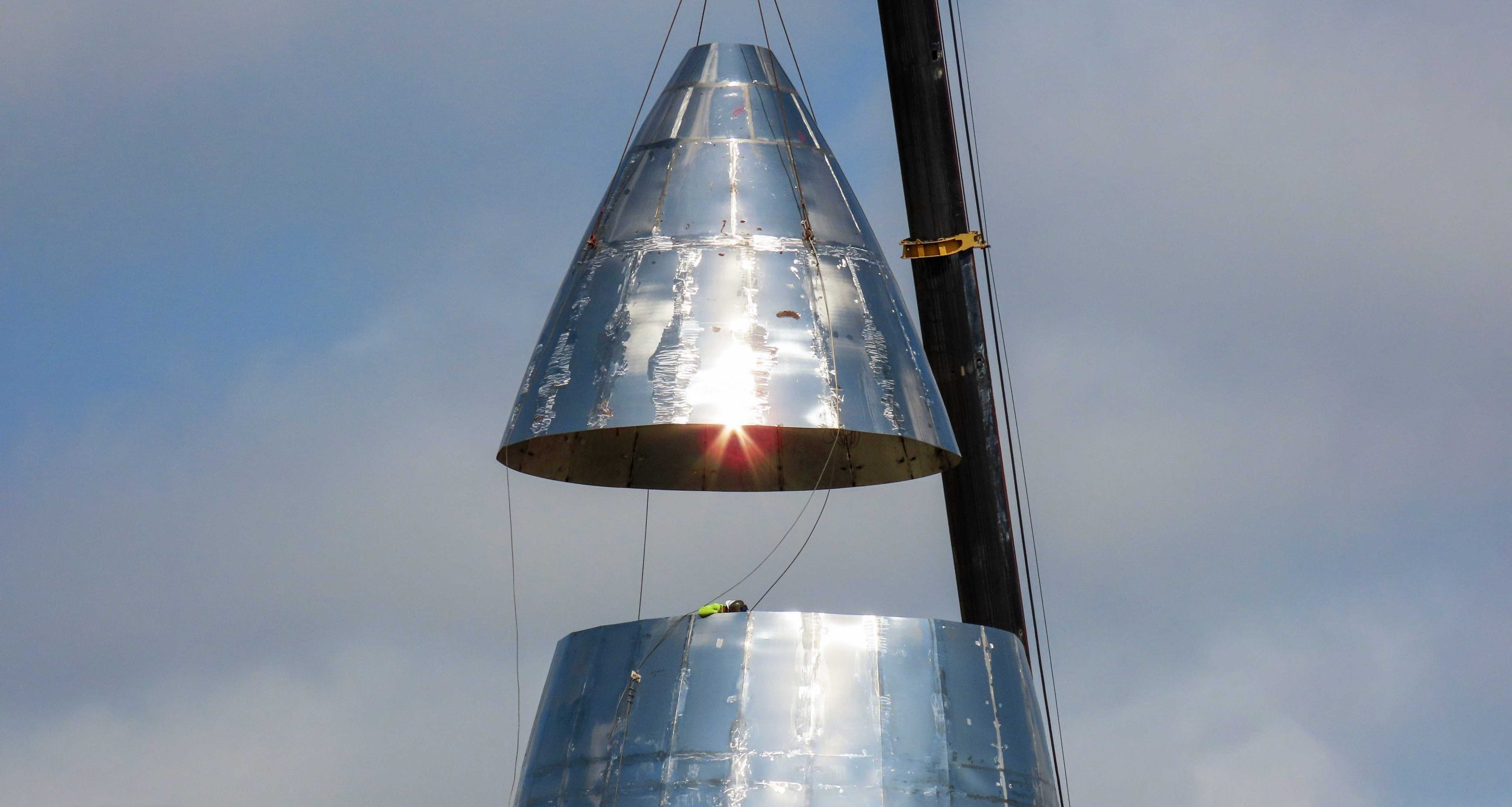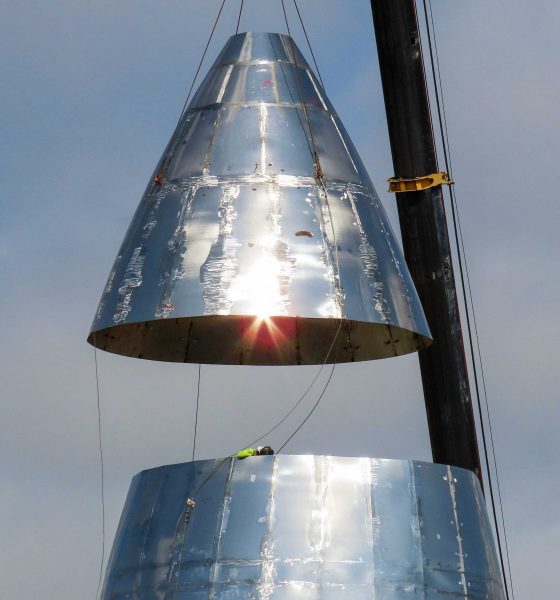

News
SpaceX CEO Elon Musk wants to use Starships as Earth-to-Earth transports
SpaceX CEO Elon Musk indicates that the company is analyzing the use of single-stage Starship spacecraft as a potential pillar of its rapid Earth-to-Earth transport ambitions, meant to realize hypersonic mass-transit at “business-class” prices.
The consequences of such a move are varied but the gist is fairly simple: by cutting down on the complexity of the hardware and infrastructure involved, Earth-based transport via reusable rockets immediately becomes a far more intriguing (and plausible) proposition. Huge challenges remain, but many of those challenges could potentially become identical to those that Starship must already face to achieve SpaceX’s ultimate goal of Mars colonization.
As discussed on Teslarati just ~24 hours ago, using extremely large rockets to quickly, reliably, and safely transport humans around the Earth sounds great on paper but runs into a huge number of brick walls after just a cursory analysis. The single most important aspect of any high-volume form of mass transit is passenger safety – if a method consistently demonstrates that it is likely to kill passengers, it will die a very quick death to public opinion and regulatory fury.
From a statistical standpoint, rockets are thousands of times less safe than passenger aircraft, in large part due to their complexity and cost. As it turns out, an almost invariably foolproof method of improving the safety of a given thing is reducing its complexity (within moderation, of course). The fewer the parts there are, the fewer the parts that can fail and the easier (and cheaper) gathering data and evidence will be.
Originally, SpaceX’s 2017 Earth-to-Earth concept relied on a full two-stage BFR rocket (now Starship/Super Heavy) that could transport passengers anywhere on Earth in 30-60 minutes. Expected to launch off of giant, floating platforms, boosters would launch and land on the same platform while sending Starships on there way around the world. Starships would head to identical platforms at their destination and land directly beside that platform’s booster.
In general, this concept at least seemed serviceable, even if it didn’t exactly scream “practical solution!” Thankfully, much like BFR itself has radically changed in the last 18 or so months, it appears that SpaceX’s concept of Starship-based Earth transportation services has also continued to evolve. According to Musk’s May 30th tweets on the subject, one obvious method of improving the viability of the concept involves entirely removing the booster (Super Heavy) from the picture.

In an instant, SpaceX’s concept of Earth-to-Earth transport starts to look more like an exotic version of proposed supersonic and hypersonic transport solutions. By leaning on lone Starship spacecraft, incapable of reaching orbit by themselves, Musk believes that SpaceX could transport passengers up to ~10,000 km at speeds as high as “Mach 20” (6.9 km/s, 15,500 mph). This is undeniably a downgrade from “anywhere on Earth in less than an hour”, but it would still easily trounce any existing mode of transport and could potentially lend itself to actual suborbital spaceports located in key areas.
At the speeds described, SpaceX could offer ~20-minute trips from New York City to London or ~40-minute trips from Los Angeles to Tokyo as just two examples. Lack of range would certainly limit the potential utility and ubiquity of such a transport service, but there are undeniably enough niche markets to sustain something like that. By relying entirely on Starship, transportation could become far similar to airliner-style travel, while keeping speeds well below orbital velocity would give the spacecraft’s heat shield a much easier time.
For now, at least, the SpaceX dream of global, hypersonic mass-transit is clearly still alive and well, even if the hurdles ahead of it remain no less imposing. According to President and COO Gwynne Shotwell, SpaceX could begin offering Earth-to-Earth transport services as early as 2025, if not earlier with Musk’s proposed Starship-only variant.
Check out Teslarati’s Marketplace! We offer Tesla accessories, including for the Tesla Cybertruck and Tesla Model 3.

Elon Musk
Elon Musk and Tesla AI Director share insights after empty driver seat Robotaxi rides
The executives’ unoccupied tests hint at the rapid progress of Tesla’s unsupervised Robotaxi efforts.

Tesla CEO Elon Musk and AI Director Ashok Elluswamy celebrated Christmas Eve by sharing personal experiences with Robotaxi vehicles that had no safety monitor or occupant in the driver’s seat. Musk described the system’s “perfect driving” around Austin, while Elluswamy posted video from the back seat, calling it “an amazing experience.”
The executives’ unoccupied tests hint at the rapid progress of Tesla’s unsupervised Robotaxi efforts.
Elon and Ashok’s firsthand Robotaxi insights
Prior to Musk and the Tesla AI Director’s posts, sightings of unmanned Teslas navigating public roads were widely shared on social media. One such vehicle was spotted in Austin, Texas, which Elon Musk acknowleged by stating that “Testing is underway with no occupants in the car.”
Based on his Christmas Eve post, Musk seemed to have tested an unmanned Tesla himself. “A Tesla with no safety monitor in the car and me sitting in the passenger seat took me all around Austin on Sunday with perfect driving,” Musk wrote in his post.
Elluswamy responded with a 2-minute video showing himself in the rear of an unmanned Tesla. The video featured the vehicle’s empty front seats, as well as its smooth handling through real-world traffic. He captioned his video with the words, “It’s an amazing experience!”
Towards Unsupervised operations
During an xAI Hackathon earlier this month, Elon Musk mentioned that Tesla owed be removing Safety Monitors from its Robotaxis in Austin in just three weeks. “Unsupervised is pretty much solved at this point. So there will be Tesla Robotaxis operating in Austin with no one in them. Not even anyone in the passenger seat in about three weeks,” he said. Musk echoed similar estimates at the 2025 Annual Shareholder Meeting and the Q3 2025 earnings call.
Considering the insights that were posted Musk and Elluswamy, it does appear that Tesla is working hard towards operating its Robotaxis with no safety monitors. This is quite impressive considering that the service was launched just earlier this year.
Elon Musk
Starlink passes 9 million active customers just weeks after hitting 8 million
The milestone highlights the accelerating growth of Starlink, which has now been adding over 20,000 new users per day.

SpaceX’s Starlink satellite internet service has continued its rapid global expansion, surpassing 9 million active customers just weeks after crossing the 8 million mark.
The milestone highlights the accelerating growth of Starlink, which has now been adding over 20,000 new users per day.
9 million customers
In a post on X, SpaceX stated that Starlink now serves over 9 million active users across 155 countries, territories, and markets. The company reached 8 million customers in early November, meaning it added roughly 1 million subscribers in under seven weeks, or about 21,275 new users on average per day.
“Starlink is connecting more than 9M active customers with high-speed internet across 155 countries, territories, and many other markets,” Starlink wrote in a post on its official X account. SpaceX President Gwynne Shotwell also celebrated the milestone on X. “A huge thank you to all of our customers and congrats to the Starlink team for such an incredible product,” she wrote.
That growth rate reflects both rising demand for broadband in underserved regions and Starlink’s expanding satellite constellation, which now includes more than 9,000 low-Earth-orbit satellites designed to deliver high-speed, low-latency internet worldwide.
Starlink’s momentum
Starlink’s momentum has been building up. SpaceX reported 4.6 million Starlink customers in December 2024, followed by 7 million by August 2025, and 8 million customers in November. Independent data also suggests Starlink usage is rising sharply, with Cloudflare reporting that global web traffic from Starlink users more than doubled in 2025, as noted in an Insider report.
Starlink’s momentum is increasingly tied to SpaceX’s broader financial outlook. Elon Musk has said the satellite network is “by far” the company’s largest revenue driver, and reports suggest SpaceX may be positioning itself for an initial public offering as soon as next year, with valuations estimated as high as $1.5 trillion. Musk has also suggested in the past that Starlink could have its own IPO in the future.
News
NVIDIA Director of Robotics: Tesla FSD v14 is the first AI to pass the “Physical Turing Test”
After testing FSD v14, Fan stated that his experience with FSD felt magical at first, but it soon started to feel like a routine.

NVIDIA Director of Robotics Jim Fan has praised Tesla’s Full Self-Driving (Supervised) v14 as the first AI to pass what he described as a “Physical Turing Test.”
After testing FSD v14, Fan stated that his experience with FSD felt magical at first, but it soon started to feel like a routine. And just like smartphones today, removing it now would “actively hurt.”
Jim Fan’s hands-on FSD v14 impressions
Fan, a leading researcher in embodied AI who is currently solving Physical AI at NVIDIA and spearheading the company’s Project GR00T initiative, noted that he actually was late to the Tesla game. He was, however, one of the first to try out FSD v14.
“I was very late to own a Tesla but among the earliest to try out FSD v14. It’s perhaps the first time I experience an AI that passes the Physical Turing Test: after a long day at work, you press a button, lay back, and couldn’t tell if a neural net or a human drove you home,” Fan wrote in a post on X.
Fan added: “Despite knowing exactly how robot learning works, I still find it magical watching the steering wheel turn by itself. First it feels surreal, next it becomes routine. Then, like the smartphone, taking it away actively hurts. This is how humanity gets rewired and glued to god-like technologies.”
The Physical Turing Test
The original Turing Test was conceived by Alan Turing in 1950, and it was aimed at determining if a machine could exhibit behavior that is equivalent to or indistinguishable from a human. By focusing on text-based conversations, the original Turing Test set a high bar for natural language processing and machine learning.
This test has been passed by today’s large language models. However, the capability to converse in a humanlike manner is a completely different challenge from performing real-world problem-solving or physical interactions. Thus, Fan introduced the Physical Turing Test, which challenges AI systems to demonstrate intelligence through physical actions.
Based on Fan’s comments, Tesla has demonstrated these intelligent physical actions with FSD v14. Elon Musk agreed with the NVIDIA executive, stating in a post on X that with FSD v14, “you can sense the sentience maturing.” Musk also praised Tesla AI, calling it the best “real-world AI” today.








